Select a theme to learn more
Select an image to learn more
Torah Binder
A Torah binder keeps the Torah closed when it is not in use. Different traditions of its form and decoration have arisen in various communities. For example, in Germanic lands the swaddling cloth for the circumcision ceremony of a male child was later decorated with words and images to wish him well. In Italy women embroidered floral patterns and sometimes inscriptions on a length of cloth expressing hopes and thanks for important events.
Lamp
Lamps play an important role in Jewish ritual: they are lit to usher in the Sabbath and holidays and to memorialize the deceased. An eternal light (ner tamid) hangs above the Torah ark in every synagogue, symbolizing God’s eternal presence.
During the Middle Ages, Jews living in Ashkenaz (Germanic lands) used star-shaped hanging lamps, identical to secular ones, for kindling the Sabbath lights. This type of lamp came to be known as a Judenstern (Jewish star). Long after these hanging lamps were no longer used for general domestic purposes, Ashkenazi Jews continued to light them on the Sabbath and during festivals. For one year after a person’s death, it was customary for Jews of North Africa to light a memorial lamp that was inscribed with the deceased’s name on the Sabbath and for festivals at home. The lamp was then dedicated to the synagogue.
Lamp
Lamps play an important role in Jewish ritual: they are lit to usher in the Sabbath and holidays and to memorialize the deceased. An eternal light (ner tamid) hangs above the Torah ark in every synagogue, symbolizing God’s eternal presence.
During the Middle Ages, Jews living in Ashkenaz (Germanic lands) used star-shaped hanging lamps, identical to secular ones, for kindling the Sabbath lights. This type of lamp came to be known as a Judenstern (Jewish star). Long after these hanging lamps were no longer used for general domestic purposes, Ashkenazi Jews continued to light them on the Sabbath and during festivals. For one year after a person’s death, it was customary for Jews of North Africa to light a memorial lamp that was inscribed with the deceased’s name on the Sabbath and for festivals at home. The lamp was then dedicated to the synagogue.
Lamp
Lamps play an important role in Jewish ritual: they are lit to usher in the Sabbath and holidays and to memorialize the deceased. An eternal light (ner tamid) hangs above the Torah ark in every synagogue, symbolizing God’s eternal presence.
During the Middle Ages, Jews living in Ashkenaz (Germanic lands) used star-shaped hanging lamps, identical to secular ones, for kindling the Sabbath lights. This type of lamp came to be known as a Judenstern (Jewish star). Long after these hanging lamps were no longer used for general domestic purposes, Ashkenazi Jews continued to light them on the Sabbath and during festivals. For one year after a person’s death, it was customary for Jews of North Africa to light a memorial lamp that was inscribed with the deceased’s name on the Sabbath and for festivals at home. The lamp was then dedicated to the synagogue.
Lamp
Lamps play an important role in Jewish ritual: they are lit to usher in the Sabbath and holidays and to memorialize the deceased. An eternal light (ner tamid) hangs above the Torah ark in every synagogue, symbolizing God’s eternal presence.
During the Middle Ages, Jews living in Ashkenaz (Germanic lands) used star-shaped hanging lamps, identical to secular ones, for kindling the Sabbath lights. This type of lamp came to be known as a Judenstern (Jewish star). Long after these hanging lamps were no longer used for general domestic purposes, Ashkenazi Jews continued to light them on the Sabbath and during festivals. For one year after a person’s death, it was customary for Jews of North Africa to light a memorial lamp that was inscribed with the deceased’s name on the Sabbath and for festivals at home. The lamp was then dedicated to the synagogue.
Portraits
Miniature portraits were important ways of remembering loved ones and were produced in a variety of media. Profile silhouettes made of cut-out paper were all the rage from colonial times until the advent of photography in the mid-nineteenth century. Other portraits here are painted on ivory, a technique that became popular in the early eighteenth century. These precious pieces were often worn like jewelry.
Travel Items
Printed picture postcards are a fairly new phenomenon, first appearing in Europe around 1870. Jewish New Year greetings of the early twentieth century often used commercial cards marketed for other purposes.
Amulets
Jewish amulets, known since antiquity, were thought to offer protection from evil forces and catastrophes, as well as from the travails of childbirth and disease. The written word—the names of God and of angels and incantations against demons—has the greatest power, but materials, colors, and representations are also believed to ward off danger.
Jewelry
Since antiquity jewelry has played a social role beyond mere adornment. Gold and gems convey economic status, whether in the ancient Mideast or today.
Work
Torah binder
Date
1750 (date of inscription)
Artist
Unknown
Place Made
Germany
Medium
Linen embroidered with silk thread
Credit Line
Gift of Dr. Harry G. Friedman, F 4612
This beautifully embroidered Torah binder is filled with charming animals and birds, but is missing its first section, which would have listed the name of the boy on whose behalf it was dedicated. The date of his birth and the name of his father, Alexander Segal, however, are inscribed in Hebrew on the surviving sections. The baby was born on the day after the harvest holiday of Shavuot in the year [5]510 [=June 12, 1750], under the sign of Gemini. The zodiac symbol is also included.

Work
Wall sconce
Date
c. 1920
Artist
Sharar Cooperative
Bezalel School
Founded in Jerusalem, 1906
Place Made
Jerusalem
Medium
Repoussé and cast brass
Credit Line
Gift of Dr. Harry G. Friedman, F 3798
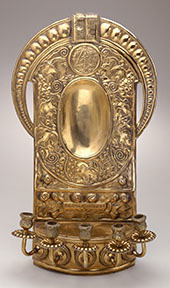
Work
Memorial lamp
Date
1929 (date of inscription)
Artist
Unknown
Place Made
Probably Tunisia
Medium
Repoussé, pierced, and cast silver and glass
Credit Line
Purchase: the Jewish Museum Volunteer Association Gift in memory of Elizabeth Cats and Anna Ternbach, 1999-108a-b
The lamp is inscribed in Hebrew in memory of Shimon Parinti.

Work
Sabbath and festival lamp
Date
Eighteenth century
Artist
Unknown
Place Made
Germany
Medium
Cast brass
Credit Line
Gift of the Danzig Jewish Community, D 94

Work
Eternal Light
Date
1978
Artist
Ludwig Yehuda Wolpert
American, born in Germany, 1900, died in 1981
Place Made
New York
Medium
Pierced silver and fiberglass
Credit Line
Gift of Herbert and Shirley Jacobs, in memory of Naomi Routtenberg, JM 30-78
This lamp is inscribed in Hebrew with the phrase “a fiery law unto them,” a biblical quotation from Deuteronomy 33:2.

Work
Portrait miniature of a member of the Brandeis family
Date
1830
Artist
Emmanuel Thomas Peter, Austrian, born in 1799, died in 1873
Medium
Paint on ivory
Credit Line
Gift of Elizabeth Stambler on behalf of the Estate of Irma Brandeis, 1990-127

Work
Portrait miniature of a member of the Brandeis family
Date
1830
Artist
Emmanuel Thomas Peter, Austrian, born in 1799, died in 1873
Medium
Paint on ivory
Credit Line
Gift of Elizabeth Stambler on behalf of the Estate of Irma Brandeis, 1990-125
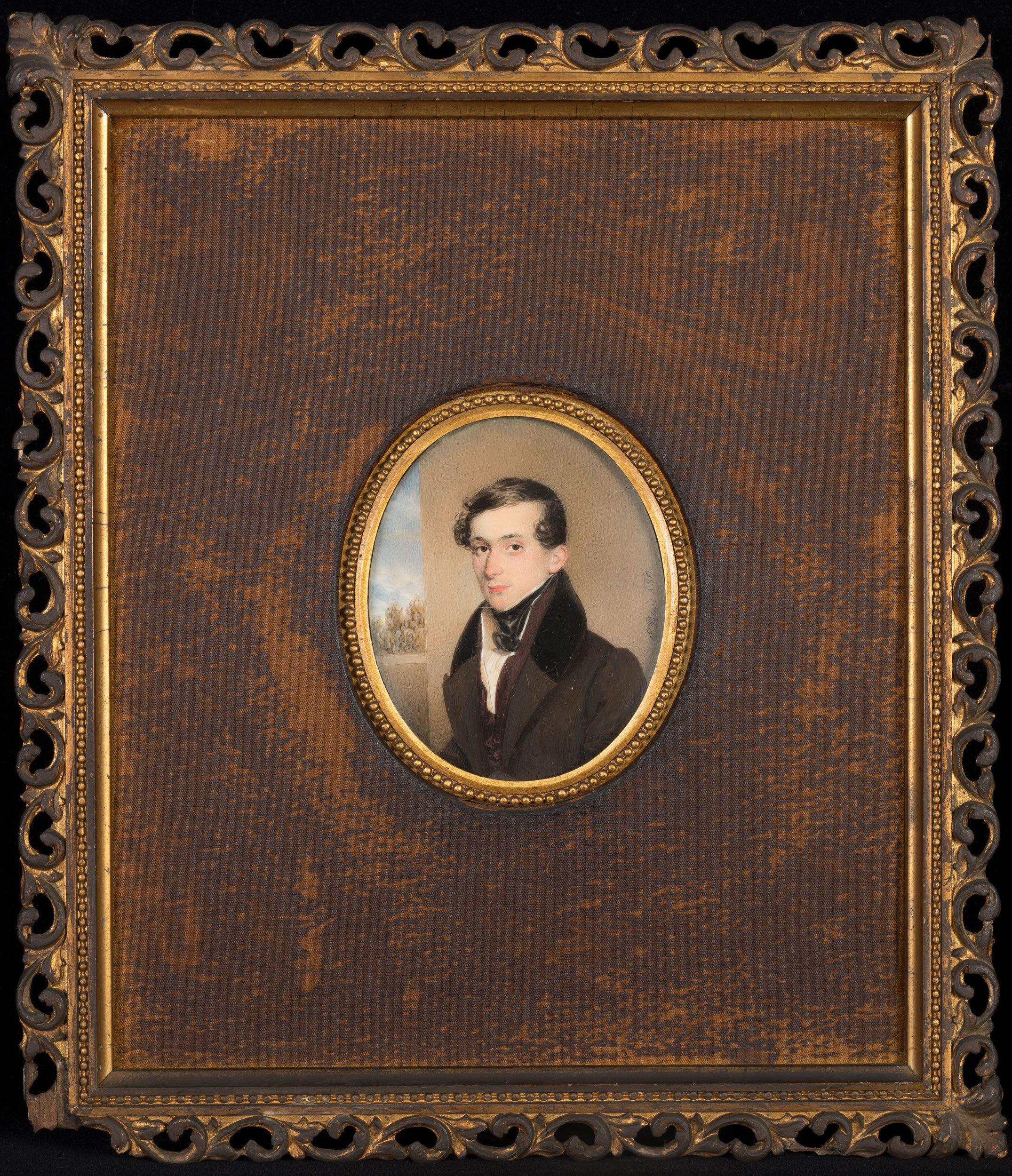
Work
Portrait miniature of a member of the Brandeis family
Date
Early nineteenth century
Artist
Unknown
Medium
Paint on ivory
Credit Line
Gift of Elizabeth Stambler on behalf of the Estate of Irma Brandeis, 1990-126

Work
Portrait of Pesquette Levi Padoa
Date
Nineteenth century
Artist
Unknown
Medium
Paint on ivory
Credit Line
Bequest of Paola Soria Sereni, 1994-605

Work
Portrait of Sally Salomon Andrews (1779–1854)
Date
1846
Artist
Frederick R. Spencer
American, 1806–1875
Place Made
New York
Medium
Oil on canvas
Credit Line
Gift of Howard Dreyfous, JM 70-75
Sally Salomon Andrews was the daughter of Haym Salomon, a patriot and spy for the American army during the Revolutionary War. Salomon was also a successful merchant who fought for the political rights of Jews. The portrait was given to the Jewish Museum by Howard Dreyfous, the great-great-grandson of Andrews.
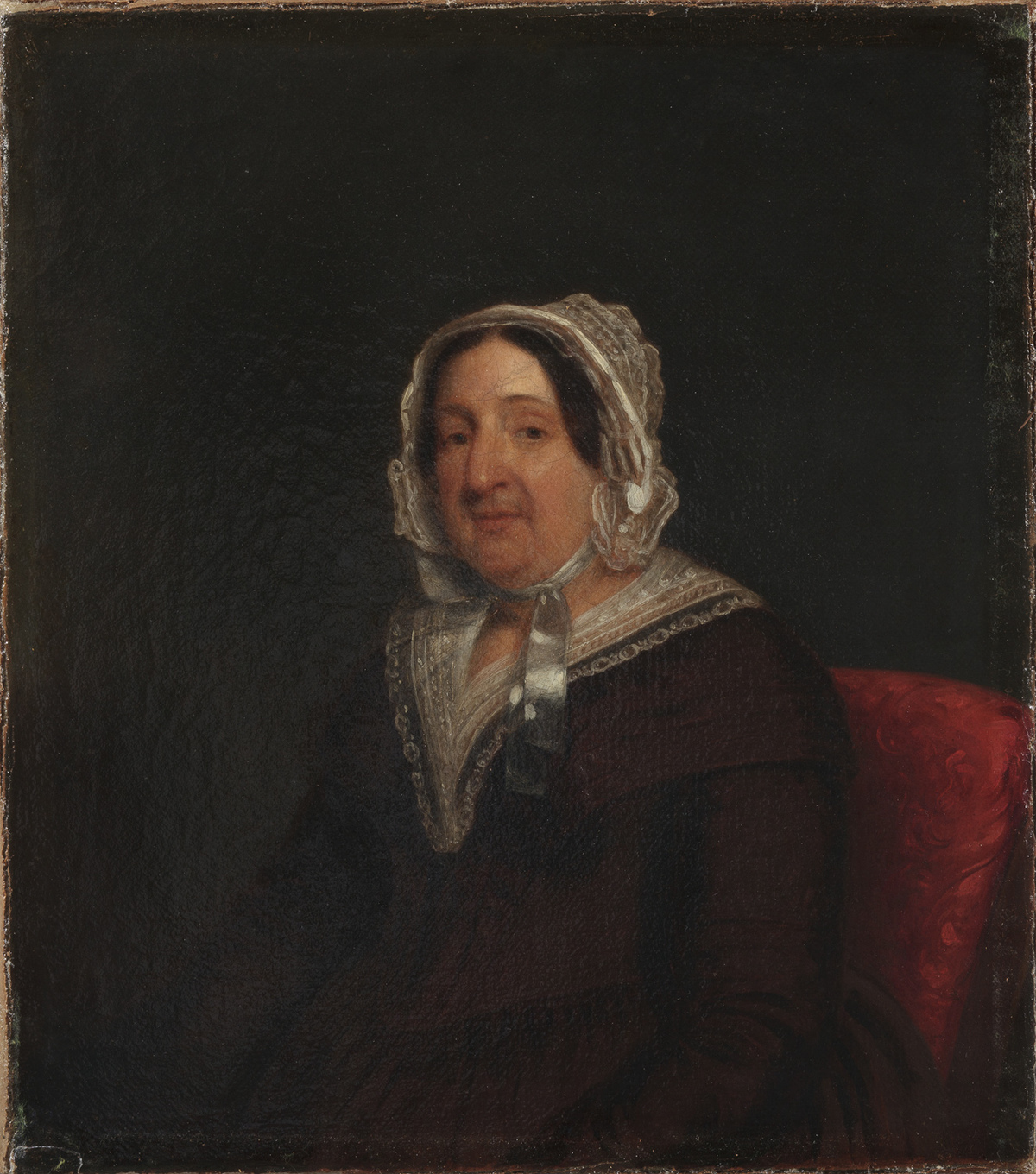
Work
New Year’s greeting
Date
c. 1915
Artist
Printer: Williamsburg Art Co., New York, dates of founding unknown
Place Made
Germany
Medium
Ink on paper
Credit Line
NC 258

Work
New Year’s greeting
Date
c. 1915
Artist
Printer: Williamsburg Art Co., New York, dates of founding unknown
Place Made
Germany
Medium
Ink on paper
Credit Line
NC 256
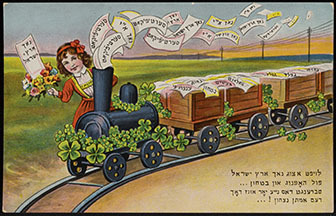
Work
Cane
Date
c. 1850
Artist
Unknown
Place Made
Obrzycko, Poland
Medium
Wood and engraved silver
Credit Line
Gift of Sol M. Stroock, grandson of S. M. Struck, S 857
This cane was presented to Shlomo Michael Struck, rabbi of the town of Obrzycko, Poland.

Work
Hanukkah lamp
Date
Probably eighteenth century with later additions
Artist
Unknown, stamped with maker’s initials J I
Place Made
Probably Germany
Medium
Traced silver and iron
Credit Line
Gift of Mr. and Mrs. William Layton, JM 108-73
Based on its compact form and lid closure, this lamp was meant to be portable, probably used when Hanukkah fell while its owner was traveling. The container, aside from the insert for oil wicks, is likely an eighteenth-century tobacco box. Starting in at least the nineteenth century, the lamp was kindled on Hanukkah by the donor’s family, who came from Freudenthal, Germany.
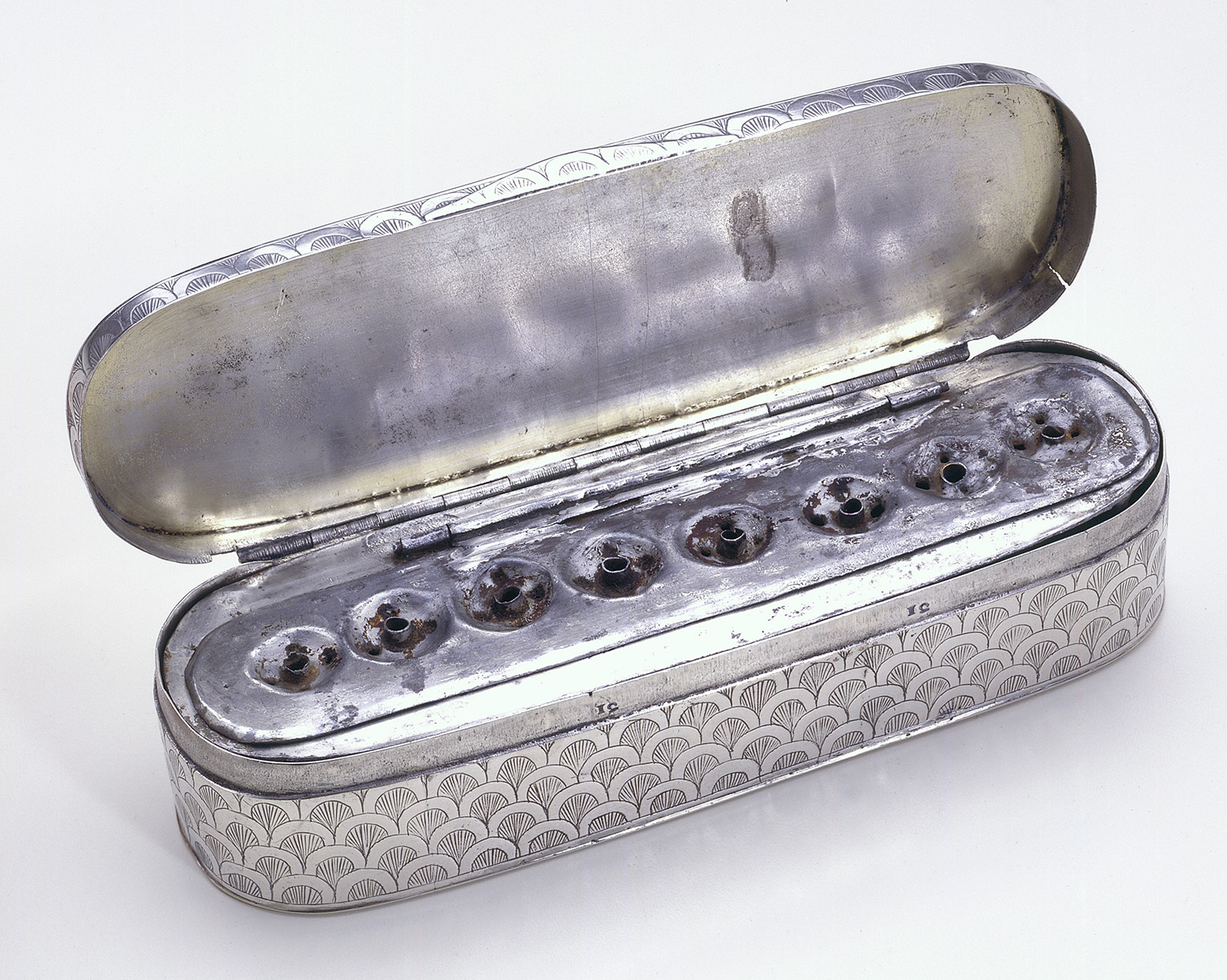
Work
New Year’s greeting showing Tel Aviv and Jaffa
Date
c. 1915
Artist
Unknown
Place Made
Germany
Medium
Ink on paper
Credit Line
NC 257
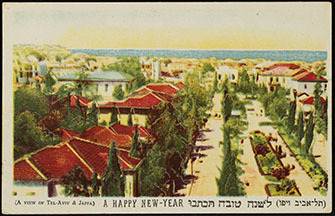
Work
Childbirth amulet
Date
Late eighteenth–nineteenth century?
Artist
Unknown
Place Made
Italy?
Medium
Carved coral, silver filigree, and glass
Credit Line
Bequest of Paola Soria Sereni, 1994-5

Work
Childbirth amulet
Date
Nineteenth century
Artist
Unknown, stamped with the maker's initials VR or IR
Medium
Silver filigree and granulation and ink on parchment
Credit Line
Gift of Dr. Harry G. Friedman, F 3102
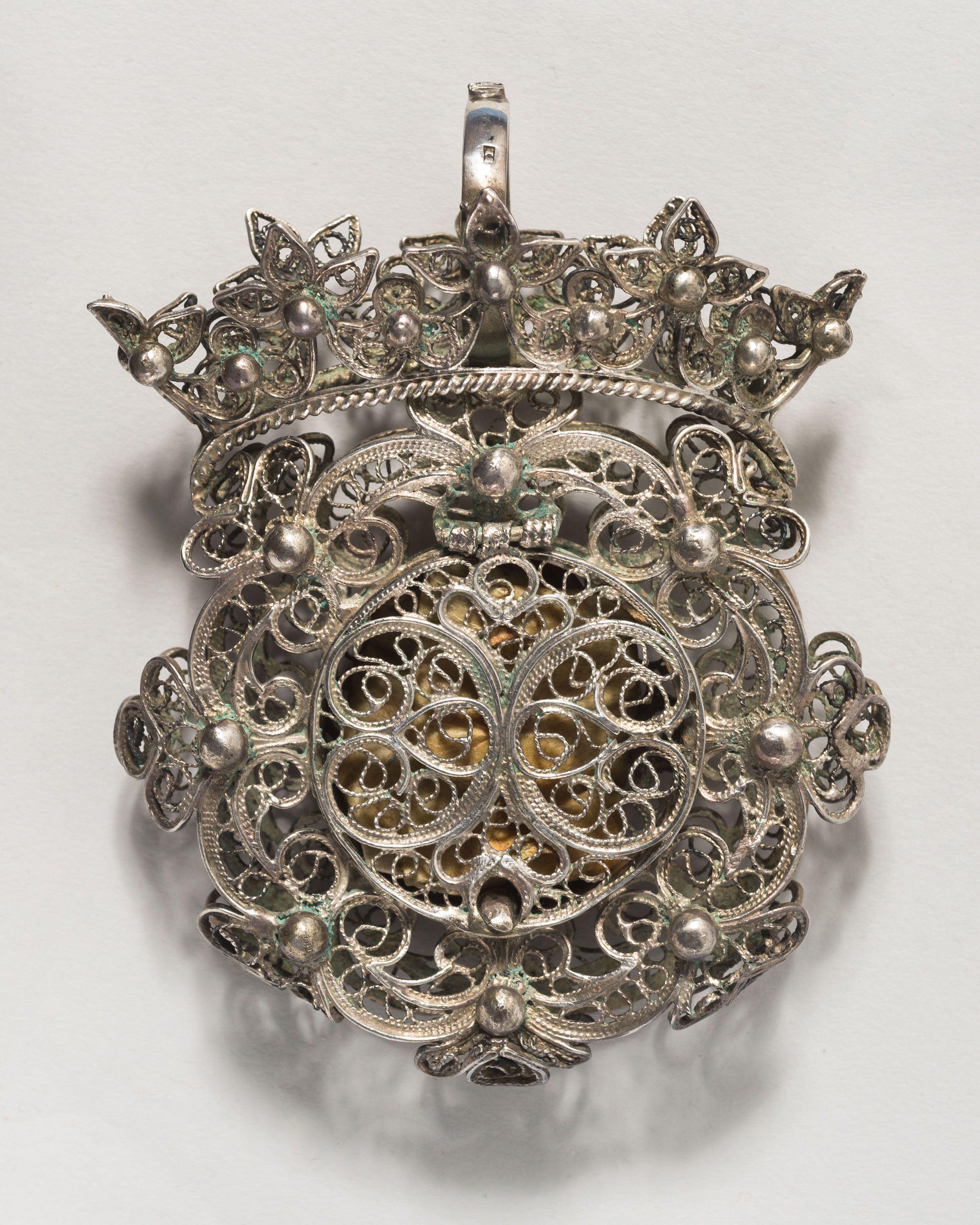
Work
Amuletic necklace
Date
Late nineteenth or early twentieth century
Artist
Unknown
Place Made
Sanaa, Yemen
Medium
Granulated, parcel-gilt, engraved, and punched silver, silver filigree and appliqué, and glass
Credit Line
Purchase: Gift of Dr. Harry G. Friedman, by exchange, 1994-76
This kind of necklace made by Jewish silversmiths,was known as a ma'anageh (choker) and was worn, twisted in the middle, on festive occasions by Jewish girls and women from San'a. An unusual aspect of this necklace is the biblical inscriptions engraved on the back of the two triangular end panels. These amuletic texts may have been added later, possibly in Israel.
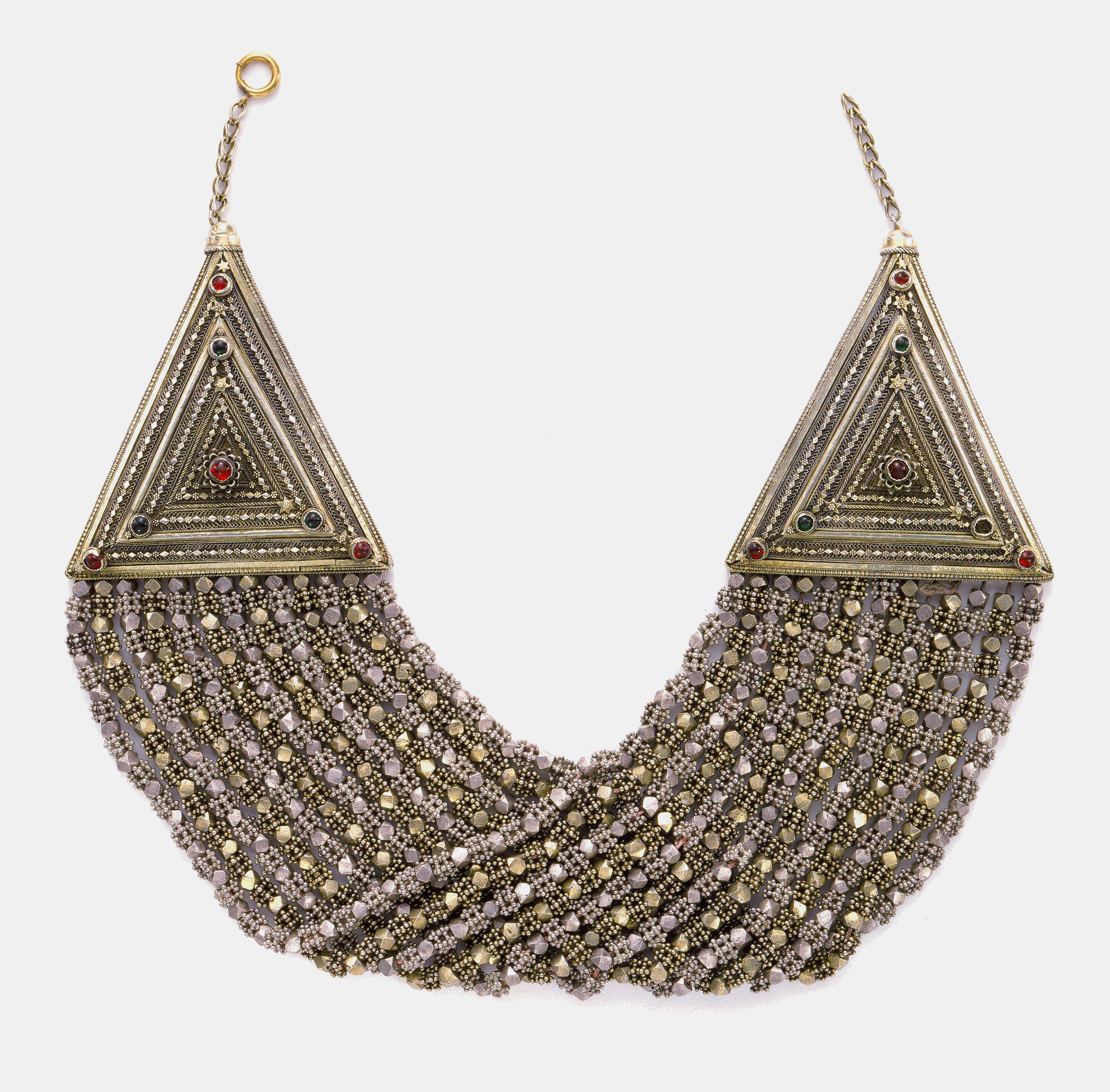
Work
Amuletic dagger
Date
Late nineteenth or early twentieth century
Artist
Unknown
Place Made
Morocco
Medium
Blade: iron; handle: wood
Credit Line
Purchase: Judaica Acquisitions Fund, 1993-198
This dagger was used in Moroccan Jewish rituals to keep demons away following the birth of a male child. During the day the dagger was placed beneath the mother's mattress. In the evening the father waved the sword around the room while the assembled guests recited prayers.

Work
Marriage ring
Date
2023
Artist
Rachel Feinstein
American, born in 1971
IPPOLITA (fabricator)
Founded in New York, 1999
Medium
Gilt silver
Credit Line
Commission: Judaica Acquisitions Committee Fund, Contemporary Judaica Acquisitions Committees Fund, and Contemporary Deaccession Fund, 2023-110
This work draws on an iconic form of Jewish ceremonial art: a ring engraved with the phrase mazal tov (good luck), expressing best wishes, and used in wedding ceremonies. A few early examples of these rings date to the Middle Ages and resemble the ancient Jewish Temple in Jerusalem, houses, castles, or synagogues. Like the huppah, the canopy under which a marriage ceremony takes place, the architectural element of these objects may symbolize the marital home of the new couple.
In her art Rachel Feinstein looks critically at historical figures and motifs and foregrounds the experiences of women. Here she interprets the symbolic mazal tov form as a four-fingered ring surmounted by a turreted castle of exaggerated size. Its multipart base resembles brass knuckles, a weapon used in hand-to-hand combat. Adding to these dark undertones, the artist also draws inspiration from decorative arts traditions of the past, reimagining a Disney-fied, romantic version of medieval Europe.
